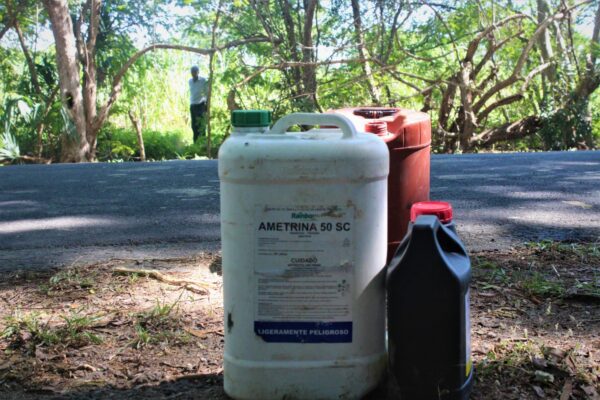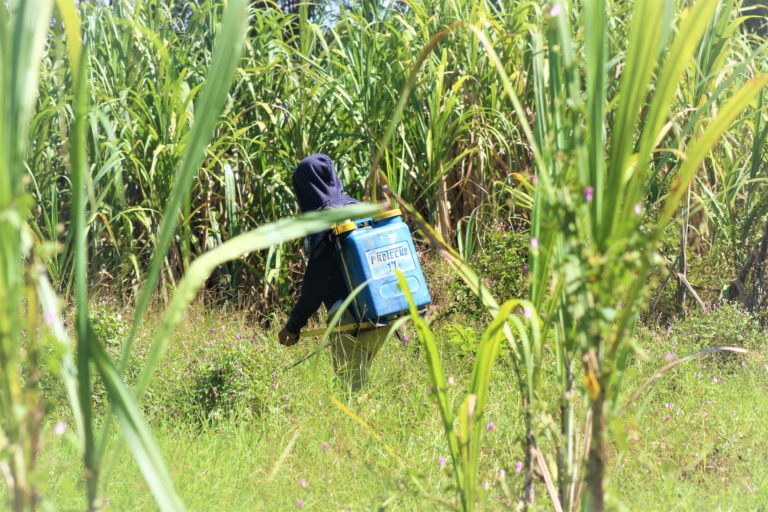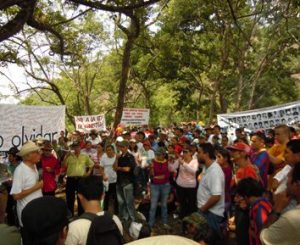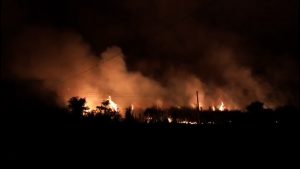Defending Natural Resources, Human Rights
Harvesting sugarcane – business of death
(ORIGINALMENTE PUBLICADO POR YSUCA)
Kimberly Vásquez would have turned 8 in August, but her body could not support the jugular catheter for dialysis that she kept for 11 months. Renal failure ended her life on March 23, 2020, in the midst of a pandemic.
She was diagnosed with nephrotic syndrome at three years of age. Most of her short life was spent traveling to the Bloom Hospital, her mother Santos Saravia, tells through her tears.
Kimberly is one of the many victims of the sugarcane industry. Her family lives in San Nicolás Lempa, Tecoluca, in the department of San Vicente where the communities are surrounded by cane fields. Her mother worked in the harvest when she was pregnant. That is how Kimberly acquired the disease, the doctor told Santos when he checked up on Kimberly for the first time.
Airplanes spray pesticides without prior notice. The poison is sprayed very close to the houses regardless of whether it kills crops, pollutes the water or kills the inhabitants.
The harvest leaves pollution and death, but it also leaves consequences for those who lose a loved one due to kidney failure.
Kimberly is buried in the courtyard of the house with the permission of the mayor and the inhabitants of San Nicolás. The Ministry of Health wanted to exhume her body arguing that she had died from Covid-19, however, the hospital documents made it clear that the cause of her death had been kidney failure.
Now Santos Saravia faces another uncertainty: his one-month-old granddaughter could have kidney problems. The doctor has recommended a renal ultrasound to rule out or confirm a new case in her family that could be kidney failure.
The Saravia house is close to the sugarcane fields, where planes at a low distance spread the poison prior to the harvest. The sugarcane growers do not notify the families when the crops will be irrigated, so it is difficult to take protection or evacuation measures.

200 people die a year from kidney failure in Zacatecoluca
The pesticides used by the sugarcane industry cause at least 200 deaths from kidney failure in the municipality of Zacatecoluca alone. This is the information that the Association for the Development of El Salvador (CRIPDES) has been able to obtain through an ongoing study on the impact of the monoculture of sugarcane on the inhabitants of Zacatecoluca, especially in Tecoluca. The data comes from a nephrologist, says Sonia Guadalupe Hernández, promoter of CRIPDES from San Vicente, who is leading the investigation.
According to the study, each year between 300 and 400 new cases of kidney failure are diagnosed in that municipality alone.
In 2002, a report from the Human Rights Office highlighted an unusual and high number of people with chronic kidney failure living in the lower Lempa. According to the report, three-quarters of those affected with end-stage kidney disease at the Rosales Hospital had been in contact with pesticides and herbicides.
That year the Office established “serious effects on the right to health as a result of environmental pollution, deficiencies in health services and a high number of cases of chronic kidney failure, especially in men and older adults.”
Despite the number of patients with kidney failure in Lower Lempa there is no nearby public clinic, nor has it been the willingness to declare a state of emergency.
The representative of CRIPDES from San Vicente stressed that this year two people from Tecoluca died at the Rosales Hospital waiting their turn to be treated for kidney disease. Those who are sick and their families do everything they can to hold on to life. They sell land and livestock to get money and heal.
Treating the disease in private hospitals is more expensive, says Sonia Hernández. Some patients require daily dialysis at a cost of $150 each.
Kidney failure is not acquired from one day to the next. Villagers can spend years absorbing herbicides, pesticides, and ripeners before being diagnosed with the disease.
Those who live among the cane fields and survive by harvesting spend almost the whole year exposed to pesticides. José Rosales, a resident of Agua Zarca, Zacatecoluca, knows that very well. He lives off the sugarcane industry.
The cane fields are fumigated four times a year, José explained. The first is a fertilizer or sealant after planting. This irrigation is done with a tractor.
The second irrigation is to kill blight, especially the coralillo that could kill the entire crop. For this, they use the pesticide counter, a highly toxic product that according to the warning on its label can be fatal if ingested, inhaled or absorbed through the skin. To water it, workers need to wear gloves and a mask. However, there are workers who do not have the protective equipment, since companies do not provide them and they would have to purchase it by themselves.
According to José, Counter can reach up to 5 kilometers from the place where it was applied. As if that were not enough, the insecticide cans are thrown into the rivers, causing contamination in the water used by those living in the communities.
The third irrigation is with a pump also to kill pests. They use the chemicals called piranha and karate. The last application is the ripening agent that is intended to burn the cane and prepare for the new sowing. This irrigation is done by helicopter or plane and it is the most dangerous because it is done at low altitude and affects the water, the crops and the health of the inhabitants.
Only in the Lombardia farm where José usually works, there are 13 communities that are exposed to agrochemicals. The San Antonio River crosses that farm, which the land owners close during the summer to water the cane. By the month of February, the river’s water no longer reaches the communities, as it is retained by a reservoir manufactured by the sugarcane producers.
The inhabitants who live from fishing are affected by these illegal actions.
Labor insecurity due to the sugar harvest
The harvest begins on November 20, a job that most of the families in the Agua Zarca area do. Although the harvest implies an income for rural communities, it also leads to labor exploitation. A day’s work is paid at $6 dollars which implies working from 6:00 to 10:00 in the morning. The time has been reduced due to demonstrations and pressure from the workers themselves.
Employers sometimes threaten workers to use machinery instead. For fear of being out of work, workers agree to low pay and long hours.
Work has become more complicated but the salary remains the same, explains José. He is talking about the fact that now the cane is planted in pineapple furrows, which further complicates the extraction. Harvesting sugarcane can last from 6 in the morning until 12 noon for the same 6 dollars. More cane is harvested for the same price, which benefits the owners.
When the workers are from other communities, the exploitation is greater. The transport arrives to pick them up at 3 in the morning and they return home at 4 or 5 in the afternoon.
The burning of the cane is another problem for the health of the inhabitants. Sometimes the fire spreads to the houses and people have been evacuated.
The fire also destroys the fauna, says José Carlos Jiménez, a resident of the El Coco community. He assures that there are more and more cane fields around the communities. In El Coco there are an average of 90 people, about 29 families. Almost all of them work in the sugarcane fields and are vulnerable to the effects of pesticides.
La zafra: el negocio de la muerte. Las avionetas riegan los agrotóxicos sin previo aviso. Dejan ir el veneno a poca distancia de las viviendas sin importar que mate sembrados, contamine el agua y acabe con la vida de los habitantes.
Sonia Hernández, promotora de CRIPDES pic.twitter.com/PlNxpxP33Q— Radio YSUCA 91.7 FM (@ysuca91siete) December 25, 2020
“They take the money and leave us the ashes”
The monoculture of sugarcane affects the salty forests, one of them the mangroves in Jaltepeque. The insecticides and ripening agents are washed away during the rainy season and reach the mangroves and protected areas, affecting the fauna and flora, where shrimp and fish die. Furthermore, by the end of the harvesting season, they wash the Jiboa mill and that water goes to the river. It is a chain of effects, says Antonio Jovel of the Intercomunal IDES, of which he is president.
From the northern part of the department of San Vicente and la Paz, passing through municipalities of Zacatecoluca and Tecoluca until reaching the Jaltepeque estuary, the impact on the sugarcane cultivation is evident.
The cane burning also affects the residents, says Antonio. On some farms, cane production per year is at least 70 tons of cane per block of land, which implies huge profits for sugarcane entrepreneurs.
This community leader thinks that the entrepreneurs profit from the farmers’ work. While they take the money to the town they leave the tile, the ashes of the burns, the diseases.
Documents have been sent to the Ministry of the Environment and to the Ministry of Agriculture and Livestock informing about the impact caused by the monoculture of sugarcane. But to this moment, nothing has changed. For Antonio, there are enough laws, what is lacking is the political will to stop the impact of the death industry.



